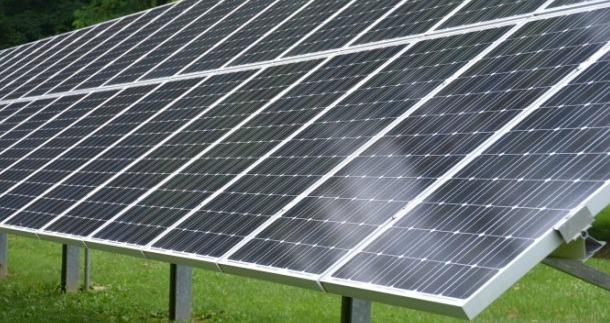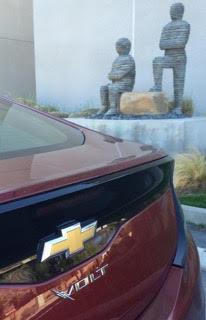Electric Vehicle Chargers: Grid Devils or Energy Angels?


By Jennifer Tuohy
President Barack Obama’s dream of 1 million electric vehicles on the road by 2015 did come true, albeit globally. And while America still lags behind by about half a million, more than 100,000 plug-in EVs were sold in the U.S. last year. That’s a 30 percent increase over 2013. The rate of adoption may not be as fast as predicted by analysts or as hoped for by the president, but it is happening. EVs are becoming a part of the American consumer landscape.
There are many groups who should be happy about this, chief among them the utility companies. EVs have the potential to be a market-changing force for the electricity industry. A report by the National Rural Electric Cooperative Association (NRECA) claims that if 100 percent of vehicles in the U.S. were fueled by electricity, consumer energy spending would shift half a billion dollars daily from the petroleum industry to the electricity industry.
That is an exciting number for utilities dealing with stagnant growth and decreasing revenues as consumers and governments adopt more energy-efficient lifestyles and policies. To some in the electricity industry, EVs are a very bright, socially and environmentally acceptable light at the end of the tunnel. Purchasing an EV will see the average American household increase its electricity use by 13 to 40 percent, translating into $340 to $515 per household, per year, according to the NRECA report.
However, the question of whether the grid can cope with EVs is an important one. As EV adoption grows, more and more consumers will charge their vehicles at home, increasing the “cluster” effect for local grids. According to EnergyBiz.com, just one or two active Level 2 Electric Vehicle Supply Equipment (EVSE) units in a neighborhood could overload a transformer. Does this mean the electricity industry will have to invest in costly infrastructure upgrades to distribution and capacity to support EVs? No — not if they can regulate how and when EVs charge.
Off-peak charging is critical
If utility companies can push EVs toward off-peak charging, then the consumer will save money and the grid can remain not only stable, but also more efficient. By charging off-peak, generally at night when less electricity is used, EVs would fill in the traditional “valleys” in system demand, helping to distribute overall energy use.
For example, a report for the Vermont Agency of Transportation, where EVs have seen a quarterly growth rate of nearly 40 percent since July 2012, found that if charging occurs off-peak, the Vermont grid is capable of supporting more than 100,000 EVs without needing to expand capacity. Similar studies across the country came to the same conclusions. This study found that, if charged overnight, 73 percent of the current number of cars in the U.S. could be EVs without the need for a single additional power plant.
However, as EV adoption grows and the proliferation of public charging stations, workplace stations and DC fast-charge stations follow suit, more and more EVs will be charging at peak times, such as during the middle of the day at work or on long road trips. When that stage is reached, the ability to control the release of power on the grid will be crucially important. To do this necessitates a smart grid.
EVs and the smart grid
A smart grid is comprised of sensors and two-way communication abilities built into the grid, the EV and the EVSE. In theory, the smart grid will be able to use the data it receives from the sensors to balance the power supply and EV demand responsively, and avoid overloading the grid. This is called demand response, and many believe it will be crucial to the long-term success of EV adoption.
In the short-term, however, EVs are not putting a strain on the grid.
“Right now, EVs are less than 1 percent of the new-car market in the U.S., and they'll have to get to a very high percentage to really need much flexibility around them on the grid,” says Zachary Shahan, director and chief editor of CleanTechnica.com, the top clean technology-focused news and analysis website in the world, and founder of electric vehicle media site EVObsession.com.
“For example, EVs have been accounting for less than 25 percent of the Norwegian new-car market, and I haven't heard of the electric grid facing any issues from that,” he adds. “By the time EVs pose a significant challenge for utilities, I think this sort of smart grid technology will be the norm. Naturally, though, its development is being hastened by forward-thinking entrepreneurs, large corporations and utilities.”
Are EVs a power storage solution for the future?
The development of the smart grid opens a huge range of possibilities beyond load control. Most intriguing is the ability for EVs to partner with the grid to store energy and discharge it when needed, making the EV an asset to the grid rather than a strain. In 2013, PG&E began a demand response pilot program to explore using EV batteries for grid stabilization.
Current grid technology leaves little room for energy storage, meaning energy has to be used as soon as it’s produced. But storage could be essential to meeting increased demand during peak periods, like when temperatures reach 90 degrees in the summer and everyone has their air conditioner running. Additionally, the current lack of grid storage renders many alternative energy sources unviable on a large scale, because there’s nowhere to put all that extra energy generated on a super-windy or super-sunny day.
Enter the EV, a potential portable mini-storage facility that sits unused for a majority of the day. Equipped with the right connections, EVs can absorb excess energy from the grid and send it back when needed. This is called Vehicle to Grid (V2G) power.
In December 2015, Nissan announced the launch of a V2G pilot project in Europe for its popular EV, the Leaf. The project allows Nissan Leaf owners and businesses with large EV fleets to create mobile energy hubs. “Electric vehicles can now become a fully integrated part of our national electricity systems right across Europe,” Paul Willcox, Nissan Europe chairman, said in a press release.
Here in the U.S., the University of Delaware has been working on V2G tech, partnering with both Honda and Nissan. However, for V2G to become a reality, an extensive (and expensive) infrastructure would need to be put in place that allows the vehicle, the grid and the end points, like homes and businesses, to communicate with each other.
Shahan notes that many are excited about this technology. But there is also some skepticism, he says, because batteries slowly lose capacity as they are discharged and charged again, meaning many owners may not want to risk decreasing the life of their battery for the benefit of the grid.
“[However], I think enough people are into the idea, and it provides enough benefit at very little cost that it will move forward,” he adds. “We've already seen and written about a number of pilot programs and initiatives where EV owners allow the local utility (or a third party) access to the car's battery in specific times or scenarios to provide brief backup, and EV owners get paid for participating.
"I think the technology is already there, and it's a matter of testing, testing, testing in order to determine what the right price is for a large enough number of EV owners to make it a useful demand-response mechanism for utilities.”
Yes, your car could power your home
In the interim, technology that lets consumers use their EVs to provide power to their homes, known as V2H, is quickly progressing.
An EV can act as an energy backup for a house by charging during off-peak times or absorbing excess energy from renewable sources, such as a home solar system. It can then supply that energy back to the house during high-demand times. EVs can also be used to power a home during an emergency, like a gas-powered generator. All that’s required is a device to hold the charge from the car that can be connected to the home’s distribution board.
The recently announced Honda Power Exporter 9000, a new product available later this year, could do this. According to Honda, it’s “an external power feeding device that enables AC power output from a fuel-cell vehicle with maximum output of 9 kilowatts.” This technology is already available in Japan, where Nissan sells a Leaf-to-Home System that resembles a giant battery and plugs into the Nissan Leaf to take on excess power. It then connects to the home’s distribution board to distribute that power when needed.
Shahan sees using an EV to power a home as a temporary solution that’s best for emergencies rather than long-term use, again because of battery capacity concerns. “I don't think a large percentage of customers would be eager to use their EV like a stationary energy storage system — they'd be better off choosing a storage system optimized for such use, like the Tesla Powerwall. For very occasional use as backup during a blackout, I think it makes sense, and it's already been done by some clever individuals in the U.S.”
The real potential for this technology lies not with the individual consumer’s EV, but in the fleets of large corporations that sit idle for predictable periods of time.
Conclusion
Electric vehicles are at a tipping point, poised to transform America’s energy consumption. Coupled with a shift away from generating electricity via fossil fuels and toward the use of renewable resources, the large-scale adoption of EVs and use of their storage capabilities is a vital step in the quest to end dependence on dirty power and push us toward a cleaner, greener planet. All this makes the EV an angel of the sustainability movement.
Image credits: 1) & 2) Shutterstock (purchased by the author for use in this article); 3) Courtesy of Nissan
Jennifer Tuohy is a tech enthusiast who has always been intrigued by electric vehicles and their impact on the environment. Jennifer provides insight on the best times to charge your car and the type of EV charger that’s best for you. Click here to see Home Depot's selection of EV Chargers.
Nevada Solar Jobs Threatened, Highlighted in Political Contest


In Nevada, hundreds of people are out of a job while residential customers are left wondering if they made the right choice to go solar. Rule changes in that state have created a mass exodus of leading solar industry companies. Nevada's energy controversy even entered the national spotlight due to spirited campaigning by Democratic presidential candidates.
On a recent campaign stop in the state, candidate Bernie Sanders visited with solar industry workers and criticized public utility changes affecting solar. The Vermont senator called the rule changes, "incomprehensible," the Associated Press reports.
Both Sanders and Hillary Clinton, who edged out the senator in the Nevada caucus, have bold climate change statements as part of their campaign platforms. Both have supported clean, renewable energy and steps to combat climate change, and both have been able to make timely comments on how the Nevada rule changes seem to unfairly penalize the solar industry.
The solar industry reports some of the most robust growth of any United States industry, touting more than 100,000 jobs. Yet in Nevada, jobs are at stake as top solar companies are laying off or relocating workers or otherwise pulling out of projects. This despite Nevada ranking as a top-three solar-producing state in a big year for solar energy growth.
Solar growth has happened in great part because individuals and businesses can receive benefits of net metering. This gives them credits for power produced from their own photovoltaic infrastructure. In the infancy of solar, this was heavily subsidized, less so as solar becomes more competitive with other forms of power production. Recently the Nevada Public Utility Commission made a rule change that significantly decreases the benefits solar customers can receive from net metering. This affects approximately 16,000 solar customers.
The utility has decided to phase out the ability of solar customers to receive net metering benefits over a 12-year period. This was adjusted from an earlier decision to phase out net metering over five years. An argument against net metering is that solar customers are subsidized by conventional power customers. Yet solar savings is what entices many people to try small-scale PV for the first time.
The Solar Energy Industries Association (SEIA) responded with this from its vice president of state affairs, Sean Gallagher:
“We are disappointed that despite all of the support this measure had, the Commission chose to vote against the will of Nevadans. While lengthening the transition time to 12 years instead of four will help provide a longer runway, the decision takes away Nevadans ability to choose where their power comes from."Without question, this is extremely detrimental to clean energy and job growth in the state and we do not view this as a productive step in Nevada's efforts to maximize the many benefits -- from environmental to economic -- that solar provides."
SolarCity announced it will lay off 550 workers in Nevada because of the utility rate changes. The company already discontinued sales and installation of solar products in the state.
"Telling employees they can no longer work for SolarCity is the hardest thing we've ever done," said SolarCity CEO Lyndon Rive. "These are hard-working Nevadans and a single government action has put them out of work. This is not how government is supposed to work." The company had recently opened a new training center in West Las Vegas that will now be obsolete.
SunRun also announced it will cease all Nevada operations in 2016. This means hundreds more jobs lost, including subcontracting with local installers employed by other businesses.
Bryan Miller, senior vice president of public policy and power markets at Sunrun, commented: “Nevada passed incentives to attract residents to go solar. But after baiting homeowners with incentives, the state switched the rules, penalizing solar homeowners to deliver additional profit to NV Energy. This bait and switch hurts Nevada families, many of whom are retirees on fixed incomes, and who use solar savings to meet their monthly budgets.”
Vivint Solar CEO Greg Butterfield also criticized the Nevada rule change for jeopardizing solar progress in the state. "Were we and our competitors to proceed with operations in Nevada, customers would lose money, limiting adoption only to those willing to make an environmental statement — distracting from one of the first truly disruptive energy innovations in more than 100 years. Lawmakers in other states should focus on protecting jobs and reducing consumer costs, instead of following Nevada's dated model of corporate welfare for entrenched industries."
While the industry landscape is changing in Nevada, the SEIA reports that a record-breaking 7.3 gigawatts of new photovoltaic energy capacity was installed throughout the United States in 2015. Nevada's installations were third only to those in sunny California and North Carolina.
Image courtesy FlourSackMama.com.
Balancing Profitability and Sustainability


By Kayla Matthews
Climate change is a topic at the forefront of everyone’s mind, with articles and images popping up regularly that showcase melting ice caps and animal deaths as a direct result of climate change. Everyone, from the smallest individual to the CEO of the largest corporation, has started taking steps to lessen their environmental impact.
With large companies, though, it can be hard to find the balance between environmental-mindedness and profit. What struggles do environmentally-concerned business managers face on a daily basis? How do you balance being green and making a profit?
The curse of fossil fuels
Fossil fuels are used every single day in every corner of the globe. The world consumes about 92 million barrels of oil per day and millions of tons of coal. This unchecked consumption releases hundreds of thousands of tons of harmful pollutants into the air every single year.
Where would we be, though, without the electricity produced by coal-burning power plants and the product-transportation network of trucks, ships and planes?
This is one of the biggest challenges that business managers face when trying to reduce their carbon footprint and make their company more environmentally friendly.
However, there are steps that companies can take to reduce their use of fossil fuels. Companies with large transport fleets can transition to biodiesel engines for large trucks and solar or electric vehicles for smaller individual cars. Solar- or wind-powered office buildings can help to reduce a company’s use of coal-burning power plants.
While these steps can help to reduce a company’s carbon footprint, it doesn’t make good business sense if it costs more to be environmentally friendly than the company is bringing in at the end of the year. That’s where balance comes in.
CEOs need to be more concerned
While there are plenty of companies will good intentions when it comes to improving the environmental impact of their businesses, there are not enough CEOs who think climate change is an actual threat to their businesses yet.
According to a recent poll of business owners and CEOs, most are more concerned with over-regulation, geopolitical uncertainty and the possibility of cyber attacks than they are with climate change or the damage their business could be doing to the environment.
Right now, roughly 50 percent of company owners consider climate change as an active threat. Half of a global market, while substantial, is not enough to really facilitate the changes that need to be made to improve the environmental impact of the business and industrial sectors.
Balancing profitability and sustainability
The trick, and the one thing that is going to set companies apart moving forward, is the ability balance sustainability and profitability. Setting up a solar-powered factory is a great move toward sustainability, but it does you little good if you leave yourself without the ability to buy the equipment or supplies needed to keep your company moving forward.
With that in mind, though, it is important not to discourage anyone from taking risks or trying something new. You never know what amazing innovations will come from someone willing to take a risk and what that can do to help improve your industry as a whole.
For example, in 2008, a beverage-bottling company called Florida Ice & Farm took steps to reduce the amount of water it took to prepare a liter of any given beverage. When the company started, it took a whopping 12 liters of water to prepare 1 liter of drinkable beverage, including the water used to clean and sterilize the bottles. By the time it had finished, the company reduced that water usage from 12 liters to 4.9 liters. Pepsi, standing on the shoulders of giants, was able to further reduce the water usage to an astonishing 2.2 liters per 1 liter of beverage.
That innovation, first pioneered by someone at Florida Ice & Farm, has effectively changed the entire bottling industry. This step toward sustainability is the perfect example of balancing environmental concerns and profitability.
There are many steps we can still take to improve the sustainability of our businesses without negatively impacting their profitability. Finding the delicate balance between the two will depend on each individual business and the amazing and innovative minds behind them.
Image by Viktor Hanacek
Quenching Cotton's Thirst: Reducing the Use of Water in the Cotton Lifecycle


A 2015 U.N. report predicts that the world is on track to face a 40 percent shortage of fresh (including drinkable) water in the next 15 years. If current usage habits don't change, the world will have only 60 percent of the water it needs in 2030.
Seventy percent of the earth’s fresh water goes toward agriculture production, according to the World Wildlife Fund (WWF). Most agriculture produces food for humans or livestock, but cotton, grown largely for the apparel industry, uses 3 percent of the total amount of water consumed by agriculture. In fact, WWF calls cotton "the most widespread, profitable non-food crop in the world." This cash-crop provides income for more than 250 million people worldwide and employs almost 7 percent of all labor in developing countries. Approximately half of all textiles are made of cotton.
According to WWF, it takes more than 20,000 liters (5,283 gallons) of water to produce just one kilogram (2.2 pounds) of cotton, which roughly equals one T-shirt and a pair of jeans. The cotton apparel lifecycle contains many places, from dirt to shirt to landfill, where we have made strides in reducing water consumption, but there is still work to be done.
Call for sustainable cotton-growing practices
CottonConnect (supported by C&A Foundation) and the Better Cotton Initiative (supported by WWF) are two global organizations that support farmer-level improvement to reduce water use and implement other efforts to make cotton farming more sustainable.
But since organic cotton still only makes up 1 percent of cotton farming, there are still plenty of improvements that can be made in the cotton lifecycle as a whole, concentrating on sustainable practices.
Irrigation
Ineffective use of irrigation and poor transportation and storage can lead to huge amounts of wasted water. WWF estimates about 73 percent of the global cotton crop is grown on irrigated land. Several cotton organizations like Cotton Inc., C&A Foundation and Better Cotton Initiative are working with cotton farmers to make sure that water is used effectively and efficiently.
Cotton Inc. is a U.S.-based industry research and lobbying organization (it's the one behind the "fabric of our lives" campaigns). The organization says that the majority of American-grown cotton (about 65 percent) is produced without irrigation. In the South and the Southeast, non-irrigated cotton systems dominate, while in the arid West nearly all of the crop-water requirements are met by irrigation water.
Farmers in the U.S. have improved water efficiency by 75 percent in the last 20 years, James Pruden, senior director of public relations at Cotton Inc., explained. But irrigation is still one of the villains of the water waste dilemma due to overflow and evaporation.
However, there have been many advances in irrigation like drip-irrigation installations that reduce the amount of water used to supplement rainfall, in regions where it is needed. Pruden explained that other technologies can detect where in a field the soil is dry and where it isn’t, concentrating delivery to areas where water is needed. These technologies can sometimes be financially out of reach for small farmers, but since their benefits are substantial, organizations are trying to bridge the distance.
“With CottonConnect, C&A Foundation is piloting financing schemes to give farmers greater access to drip-irrigation technology. These new irrigation systems can increase yields by 30 percent and reduce water usage by up to 60 percent,” Leslie Johnston, executive director of the C&A Foundation, wrote in the organization's More Crop Per Drop report.
Pesticide/herbicide use
Pesticides are a big dividing line between organically-grown cotton and other practices, but they also play a role in water conservation efforts when it comes to agriculture.
Pesticide use contaminates groundwater and can cause long-term pollution problems downstream from cotton farms. It is also an expensive practice, so there are several reasons that farmers are trying to curb or end pesticide use. U.S. farmers no longer apply pesticides in a cloud (a la Hollywood), Pruden explained, but they are encouraged to apply it at ground-level to a specific area, which reduces contamination. That said, any use of pesticide has the potential to affect groundwater.
Although certified organic cotton farming has lost some ground in the past few years, it looks like cotton organizations are encouraging more sustainable farming practices that steer farmers further from traditional wasteful cotton farming and more in the direction of organic principles as a whole. So, the industry is moving in a more sustainable direction, and slowly but surely, it is resulting in water savings.
Manufacturing
Manufacturing processes also use a lot of water. The dyeing process both uses a large amount of water and causes a huge amount of pollution. The water that runs off the fabric and down the drain into sewage systems pours chemicals into the groundwater, as well as rivers, lakes and other water sources.
Several brands have worked to develop processes that use less water.
Nike has a ColorDry process that eliminates "water from fabric dyeing." It also "reduces energy consumption by around 60 percent compared to traditional dyeing, eliminates the use of process chemicals, and uses nearly 100 percent of dye in the process, practically removing the potential for wastewater pollution," the company said.
Levi's launched a waterless jeans initiative that uses recycled water in parts of its process and saved 1 billion gallons of water as of 2015 by reducing the water used in garment finishing by up to 96 percent.
Consumer habits
Consumers can do several things to reduce water use for cotton products, especially apparel and household items (sheets, etc.).
The first thing consumers can do is buy less. Brands like Patagonia have even gone so far as to tell customers that they should repair their garments rather than buy new.
Another way that consumers can be aware is to find out where their clothes come from.
Eric Henry, president of TS Designs, a U.S.-based organic cotton T-shirt design company, says that his customers can look up any of their shirts to find out its journey "from dirt to shirt" using the Where Your Clothing website. TS Designs has a close relationship with their North Carolina, third-generation cotton farmer who grows their crop relying only on rainfall. The company also insists on paying a living wage to its workers up and down the supply chain, which is all within 600 miles.
The next way to conserve water is to wash your item less, use cooler water and line-dry whenever possible to use less water to clean the item and extend the life of your garment.
When a consumer tires of a garment or it is worn out, the best thing to do is donate it. In 2015, Holly McQuillan, senior lecturer at Ngā Pae Māhutonga – the School of Design, told 3p:
"The fashion industry will produce 400 billion meters of fabric [in 2015 alone] — just for apparel. This is roughly the amount of fabric it would take to cover the entire state of California. Fifteen percent, or 60 billion meters, will be wasted during the production phase (extra fabric, itself a finished product, that ends up on the cutting-room floor), before the garments even reach a consumer. The number of garments created each year is the equivalent of everyone in the world having 20 new items annually."
Annually consumers waste more than 11 million tons of textiles.
Efforts to recover these fibers will reduce the water constraints of the apparel industry by cutting the cotton-growing component out of the equation.
Manufacturers large and small are working to recover fibers for reuse. One startup, Evrnu, takes cotton garment waste, purifies it and breaks it down into a pulp -- creating, according to founder Stacy Flynn, "a pristine new fiber that is finer than silk and stronger than cotton - made entirely of garment waste." She told 3p this process uses 1 percent of the water used in the original cotton garment process.
Right now, Evrnu is the only U.S. company in the game, although there are companies working on similar technologies in the U.K., Finland and Sweden.
If cotton-farming organizations continue to promote sustainable practices, organic gains a bigger market share, and -- from the other end of the spectrum -- fiber recovery and remanufacture becomes more than a pipe dream, the water footprint of the apparel industry might ease.
Image credit: Flickr/U.S. Department of Agriculture
For-Profit Colleges As Benefit Corporations: Where's The School Spirit?


For-profit colleges are a $25 billion industry that gets no respect. They claim just 5 percent of the $500 billion Americans spend every year on higher education. Their critics call them "dropout factories" that burden students with debt and get billions in federal and state support while returning little value.
In the last few years, six for-profit colleges have re-chartered themselves to become benefit corporations, with a dual mission to pursue a public benefit while also making a profit. Are they greenwashing? B Labs, the independent social auditing firm that awards B Corp Certification and also promotes the movement for chartered benefit corporations, doesn't think so. But changing that image might take a while.
Critics of for-profit education cite a 2012 report by former Iowa Sen. Tom Harkin, which analyzed 30 for-profit colleges and found that their associate's degrees cost four times as much as did similar degrees from public schools. Harkin also found that 63 percent of students enrolled in associate programs at for-profits in 2008-09 had dropped out a year later. The expenses and yields for other degrees were also poor in comparison to public and not-for-profit schools.
Two years ago, B Labs convened a diverse group of educators to develop specific social auditing standards for higher education. The group released the standards last September. A few weeks later, Laureate Education and Alliant University passed the audit to become the first for-profit colleges that are both benefit corporations and Certified B Corps.
"People say that for-profit colleges cannot keep students at the center of their operations, but the benefit corporation structure requires that they do," says Dan Osusky, a standards manager at B Labs. "The key to making this succeed is getting colleges to publish measures of accountability and performance."
Other for-profit colleges are talking the talk. "We're a 115-year-old company, and being a public benefit corporation is in our DNA," says Trenda Boyum-Breen, president of Rasmussen College, a regionally accredited institution serving 14,000 students online and at 24 campuses. It grants degrees in business, nursing and other job-oriented disciplines.
About 75 percent of Rasmussen students are women and over the age of 25. More than a fifth are African American. "For-profit colleges have a powerful opportunity to encourage upward social mobility," Osusky of B Labs says.
Rasmussen registered as a public-benefit corporation (PBC) in Delaware two years ago. "We saw it as a way to distinguish ourselves," says Dr. Boyum-Breen, president of Rasmussen, who is also a first-generation college graduate. "A PBC is the sweet-spot that allows us to deliver education for the public good while also having the efficiency and flexibility of a for-profit business."
That all sounds good. But Rasmussen is privately owned, so it doesn't release information on its revenues, its expenses or the names of major shareholders. Boyum-Breen says the college is consulting with B Lab, but it hasn't yet been certified. And Delaware law only requires that PBCs give their shareholders a statement regarding the progress of their social goals once every two years. The statement does not have to be done by an independent third party, and it doesn't have to be public.
"This is a controversial industry, and some for-profit colleges have questionable reputations," says Osusky, who adds that the best way forward is for the industry to adopt specific performance standards, greater legal accountability and public transparency. "Controversial industries are where the need is greatest to distinguish between good and bad actors," he continues.
Boyum-Breen, who became Rasmussen's president 10 months ago, says the college's directors will see its first internally-produced social statement at their meeting in March. She says that parts of the statement will also be released to the public and that the college will continue to work with B Labs.
She is also pushing changes that promise to lower the cost of a degree. More than three quarters of her students have already attended college somewhere else without graduating. Rasmussen's Flex Choice, which combines classwork with online study to allow students to pass course units based on their prior experiences, was expanded to all degree programs in January.
"There's a great opportunity here for a business to generate public good," she says. "An organization's tax status doesn't determine whether it is good or not."
Maybe so. But you can't assess a company's performance until you measure it, and you can't trust those measurements unless someone or something holds the company accountable.
Image credit: Flickr/CollegeDegrees360
How Electric Cars Promote Weight Loss


No, the answer to how electric cars promote weight loss is not because they run out of electricity and you have to walk more. I've been driving the plug-in electric Chevy Volt for a week now. While the Volt’s battery did run out of electricity during extended trips, the car kept going because of its on-board gasoline engine.
New research links air pollution to obesity and diabetes
I came up with an outside-the-box idea that driving an electric car could promote weight loss based on just-released research by Duke University. Duke University researchers found that mammals exposed to air pollution have a higher risk of obesity and diabetes. Could it be that breathing deeply in our urban environments is as bad for our weight as drinking soda?
Obviously, driving electric cars will not solve our national weight crisis. But what we drive is part of the life choices we made that have created our national weight crisis. Seventy percent of the baby boomer generation is overweight or obese. It is projected that 50 percent of Generation Z, the first generation born in the 21st century, will be obese during their lifetime.
That is what motivated me to write "The Boomer Generation Diet." It profiles sustainable best practices that will reshape our bodies and environment for the better. What the Duke University research suggests is that the lifestyle choices that impact our weight and health now extend beyond food to include the type of cars we drive and the source of the fuel we use to generate electricity.
How fun-to-drive electric cars can promote weight loss
One of the research breakthroughs I found in my own weight-loss success is that there's a strong link between having fun and losing weight. We have all failed at dieting. We fail because dieting is a painful process based on denial or eating foods that have a taste somewhere between dull and awful.
We fail at exercising because it is painful and stressful. Who wants to walk into a gym filled with workout warriors when you're wearing plus-size shorts? "No pain, no gain" might have been motivational when we tried out for high-school sports, but in our adult lives we do not need more pain. So, we try exercising and then stop because it hurts. The couch, TV and comfort food seems the better alternative for reducing stress and pain.
Figuring out how to have fun while losing weight was my key to weight-loss success. I never go hungry. I eat a ton of good-for-me food that I think tastes good. I have figured out how to make sustained exercise seem like play by riding a mountain bike. Most days it is the best part of my day. It relieves stress. I laugh over my experiences on the trail. I lose weight.
The beach, fish tacos and the Volt
A huge step toward weight loss is getting out doors. That is where the Volt comes in. Owning a Volt makes you want to “get out there.” That is my observation of the Volt owners I follow on Facebook. They are always reporting on where they're driving their Volts.
That was certainly my experience during the week I test-drove the Volt. I went out of my way to schedule trips to the beach and desert. The following 90-second video profiles one of those trips. It is my trip to San Clemente driving a Volt.
San Clemente is one of my favorite beach towns. It has a great walking path right along the beach that is one of my favorite places in the world to walk. My dog Cooper loves it, too! I have fun. Cooper has a blast. We both keep trim.
And who wants to eat a hamburger and fries when you can sit at an outdoor restaurant on the pier and enjoy some of the best fish tacos in Southern California?
Driving an electric car not only saves money and cuts tailpipe emissions, but it can also be a fun way to find fun locations that promote weight loss. That was my experience in San Clemente!
https://www.youtube.com/embed/OTAla2RWDDQ
Image credit: Bill Roth
Fundraising Made Easy in 4 Steps


Editor's Note: This post originally appeared on the Connective Impact blog.
By Joanne Sonenshine
Whether you are an NGO employee seeking funding for your programs or a social entrepreneur exploring ways to scale your latest concept, fundraising can seem daunting. Even the most experienced fundraisers question their approaches from time to time.
Certainly the donor landscape is evolving, and with resources and priorities shifting, opportunities for funding can seem limited. With the right focus, preparation and foresight, fundraising need not be overwhelming.
I often whittle down the process in four simple steps for my clients. Try these yourself and you can be well on your way to scaling your programs and impacting your stakeholders in the most positive ways.
First and foremost, identify your aims. Make your goals clear and concise. I am not talking about dollar goals or even prospects. I am talking about what you hope to gain from your fundraising effort. Who will benefit? How and why? What does the world look like after you have completed your fundraising?
Prioritize one to three big-picture goals and include four to five activities that you plan to undertake within each goal so your donor audience knows exactly what options there are for fund dispensing. This allows you to be proactive and targeted in your prospecting. This process also ensures that you stay focused and not reactive. The worst type of fundraising is that in which you accept unallocated dollars and try to ‘make something happen.’ In every one of my experiences, this is where fundraising fails.
Second, build your prospect list based entirely on your one to three big goals. Which donors are apt to fund programs that match your end game? Do not limit yourself to big, government donors or large well-known foundations. Consider corporate donors that have business interests that match your priorities. Think about crowdfunding or target smaller, family foundations that have specific strategies for managing their donor dollars. Think creatively and don’t box yourself in. Reach out to experts if you need help identifying the donor options for your programmatic needs.
Third, undertake a matching exercise. Connect your one to three goal priorities to programmatic priorities of each donor. Do not go outside of your script, unless the opportunity arises. Donors want to see you being focused and specific around what programs and activities that need and want funding.
This process includes being clear on geographies, regions, communities, potential partners, opportunities for leverage, opportunities to utilize in-kind donations and understanding what a return looks like for a donor. By doing your homework, donors will be far more apt to fund your program than if you initiate too broad an ask.
Lastly, ask for help. It may seem counterintuitive to spend money to make money, but often times a fundraising effort cannot initiate itself. Having outside resources working on your behalf will save you time and money in the end. Consider connectors that can have conversations with high-net worth individuals on your behalf, or assign tasks to your board of directors if appropriate.
Do not discount the role existing partners can play in seeking out funding for joint projects you have underway, or simply making introductions. Finding entry points and building relationships is one of the most critical elements of fundraising, and this takes time and the right approach which cannot be managed in a vacuum.
--
By following these four steps, your organization is well-poised to be proactive and successful in fundraising and ultimately can deliver greater impact to the communities you serve.
Image credit: Pixabay
Joanne Sonenshine is Founder + CEO at Connective Impact, aiding organizations in strategic goal development, partnership creation, consensus building and focused thinking in order to solve some of the most complex problems of our time.
GrowOya Pots Allow for Easier and More Water-Efficient Gardening


Gardening is all the rage these days, and it's thriving even in densely-populated areas where urban farmers have little more than a balcony or a porch to grow those herbs or tomatoes.
But going from seed to seedling to thriving vine is not always easy. First of all, there is that pesky task of watering — most plants tend to grow better with an intense weekly watering instead of a frequent quick sprinkling of water. Of course, most of us work long days outside the home, and then there is that annoying issue of remembering to water your little garden in the first place. Then there are the watering restrictions in many communities as the majority of states here in the U.S. are either mired in, or heading toward, long-term problems due to drought.
A timeless design, however, is one water-efficiency answer to the question of how to keep that garden growing while maintaining a busy schedule and, of course, doing all of this sustainably.
GrowOya is the venture of three gardening aficionados who wanted to find an easy yet responsible way to keep gardens blooming and producing. Their terra cotta pots are based on ollas (“OY-yas”), a method of irrigation that has long been used in the Americas and has since spread across the globe.
The bulb-shaped pots are buried in gardening plots near the base-roots of plants. A narrow opening, which reduces evaporation, is exposed at ground level and only needs to be filled with water every five to 10 days. Because the pots are slightly porous, water seeps out slowly. The plant roots in one’s garden will gravitate toward the submerged pots within a few weeks, and will draw out water only when needed. Capping the spout with a rock or small tile reduces evaporation even further.
The results, say GrowOya’s founders, is a low-tech yet highly efficient watering system that is 70 percent more effective than surface watering. They can work in planters, raised beds and, of course, larger backyard and community gardens.
Plenty of artisans and small businesses make ollas, and for DIY enthusiasts, cobbling together one’s own collection of ollas is a fairly easy task. GrowOya’s founders, however, tinkered with their design and manufacturing process to make their pots even more efficient. For now these ollas, or "oyas" if that is easier to pronounce, are available for purchase within the U.S. and Canada on GrowOya’s website. Available in three different sizes, their costs start at $25.
Image credit: GrowOya
The Carbon Pawprint


This article is part of a series by students at Bard College’s MBA in Sustainability. Principles of Sustainable Management is a foundational class for all Bard MBA students. It delivers ecological and social literacy, the frameworks and tools used by sustainability professionals, the business case for more responsible treatment of people and planet, systems thinking and integrated bottom line accounting.
By Stephen P. Williams
While gauging my carbon footprint with an online calculator, I look down at my bluetick coonhound, Elvis, and wonder what his carbon pawprint is. Nearby, his buddy Alice, a black and tan coonhound, snores through it all.
Let’s see: They don’t drive; they’ve never flown on airplanes; their trash consists of the one or two plastic bags I use to pick up their poop every day. They each eat two cups daily of high-quality (a code word for “expensive") dog food.
I Google “carbon footprint of dogs” and am bombarded with a series of responses to a 7-year-old book that claims one pet dog has the same “ecological footprint” -- the amount of land needed to produce the energy consumed -- as a large SUV driven 10,000 miles a year. The book was written by two New Zealand professors named Robert and Brenda Vale, and it’s titled: "Time to Eat the Dog?"
I look down at Elvis and think: not tasty.
Turns out the book devotes only 28 of its 350 pages to pets. The main argument is that the meat consumed by dogs requires a large amount of land to produce. The rest charts all the other areas of our lives that contribute to our ecological footprints. Clearly, the dog part is a marketing tool. And I think it’s a bunch of BS.
Elvis' and Alice’s food has an average animal protein content of less than 25 percent -- depending on what flavor is in stock at my local pet store, that would be salmon, lamb, chicken or beef. But for argument’s sake, and to give the Kiwis a fighting chance, let’s assume my dogs are each eating two cups of raw meat a day, or about one pound each. According to the Environmental Working Group (EWG), it takes 13.5 kilograms (almost 30 pounds) of carbon to produce and transport one pound of beef. For each dog, that would total 2,168 tons per year. According to the EWG, a large SUV emits about 11,000 tons per year if driven 1,200 miles per month.
That figure does not include the footprint of manufacturing that SUV in the first place, which would make the figure skyrocket. And remember that my dog food calculations are based on a dog eating one pound a day of raw meat. No matter how much my dogs would like to keep a side of beef in the fridge, in truth, their dog food is made of grains, cereals and “tasty” meat byproducts -- meaning the parts of the animal, such as sinew, bones, eyeballs and skin -- that many people wouldn’t touch. So, in effect, my dogs are piggybacking on other people’s carbon footprints by eating the throwaway meat that’s discarded from the steaks and burgers.
So now Elvis can rest easy, and Alice can continue to snore. I will feed them again in the morning -- and not to myself. As they crunch away, I’ll bask in my superior status as a dog lover, knowing that cat litter often is made from strip-mined clay. No joke.
Image credit: Pixabay
Stephen P. Williams is a student in Bard College’s MBA in Sustainability program.
7 Ways Small Businesses Can Help Nonprofits


By Abby Jarvis
The relationship between small businesses (or companies of any size, for that matter) and nonprofit organizations is often mutually beneficial. Nonprofits ask for donations; companies respond by sponsoring nonprofits' important projects. Nonprofits need volunteer hours; companies have manpower and time they can offer.
Small businesses do not often have extremely developed corporate social responsibility (CSR) programs, but that doesn't mean they can't or shouldn't lend a helping hand to nonprofits.
Take a look at the primary ways small businesses can help nonprofit organizations. And while you're at it, check out the role that businesses play when it comes to social change.
1. Host a volunteer day
If you want to give your employees a chance to bond as a team and effect some positive change at the same time, why not host a volunteer day?
You can choose a local nonprofit that does work your employees are connected to in some way. For instance, if you have an office full of dog-lovers, you might want to spend a day at a local animal shelter. If your workers are always recycling and separating their paper and plastic, connect with an environmental organization to clean up your local area.
Wherever you plan on volunteering, make sure that it's a fun and memorable time for your employees.
You might even be able to form a strong partnership with the nonprofit you volunteer with. That could potentially lead to more opportunities for your employees to help improve your community.
2. Start matching your employees' donations to nonprofits
Many larger corporations match their employees' donations to nonprofit organizations. However, smaller companies often don't have an established policy for matching gifts.
If your employees enjoy giving money to their favorite charities, why not give those funds a boost and match them?
You don't necessarily have to immediately start matching gifts at a 4:1 ratio; start slow and create a program that has room to grow.
You might find it useful to limit the types of nonprofits to which your employees can donate at first. Eventually, you can expand the program to include any and all organizations to which your employees give.
Additionally, you can use your matching-gift program as a way to demonstrate your corporate social responsibility to the community.
3. Create a nonprofit resource page
Many nonprofits have a "Ways to Give" page where they explain how supporters can give to their cause. They might list out a multitude of resources so donors and volunteers can get a better idea of how to support the organization.
Your small business can create a similar resource page to give your employees a list of ways to give to nonprofits such as:
- Online donation forms
- Fundraising events
- Volunteering opportunities
- Crowdfunding pages
- Text-to-give software
- Corporate giving programs
- And more!
Having a nonprofit resource page on your company's website or posted somewhere in the office can be a good way to inspire charitable fence-sitters who may need some encouragement.
4. Consider offering skills-based services to nonprofits
This point will likely differ depending on the type of company you run or work for, but it's worth considering as a way to give back to nonprofits.
If your employees have skills or services that they can lend to an organization, encourage them to do so! You can offer legal advice, account services or marketing consultation to small nonprofits that may be unable to pay for these types of services or hire outside help.
You could also teach classes to nonprofit professionals in an area that you're familiar with.
Offering skills-based services is essentially a form of volunteerism, but it makes use of the strengths that your employees already possess. The nonprofit benefits by receiving specialized services and time from people who are skilled at what they do.
5. Apply to become a nonprofit board member
If you or someone in your company has a real passion for philanthropy, you might consider applying to become a nonprofit board member.
Granted, being a nonprofit board member is an unpaid volunteer position that might require a lot of work, but it might be a good fit for an employee who wants to serve in a more committed, long-term position.
Many nonprofit board members may be major gift donors or people with extensive knowledge of the nonprofit world, but don't let that stop anyone in your small business from pursuing a seat on a board.
6. Lend your office space
Even if you're a super small company with limited resources, you can still help nonprofits out by lending them your office space.
You'll need to talk to the organization's leadership to work out the logistics and determine what expectations are for both parties.
You might be able to help a nonprofit with their next advocacy campaign by giving them extra room to train volunteers or make signs and flyers.
Or, if a nonprofit is expanding and has outgrown its own offices, you can offer your space until it finds somewhere new.
Whatever the circumstances, lending your company's office space is a good way to forge strong business/nonprofit relationships or strengthen the ones you already have.
7. Encourage employees to attend nonprofit events
After a long day at the office, your employees might not find the idea of going to a nonprofit event the most thrilling end-of-day activity. However, attending events doesn't just result in more support for charitable organizations, but they are also great ways for your employees to have a shared experience outside of work.
Many of your employees might donate to nonprofits, but they might not have a very personal relationship with a charity.
Attending a nonprofit event, whether it's a fundraiser, rally, seminar or anything in between, can be an inexpensive way to show your support of an organization.
--
These seven ways small businesses can help nonprofits are by no means the only ones. You might find that something else works even better for your company. Tweak and adjust to find out what your employees enjoy that also gives maximum benefits to nonprofits.
What about your small business? What success have you had supporting nonprofits? What types of programs do your employees enjoy taking part in?
Graphics courtesy of the author
Abby Jarvis is a blogger, marketer, and communications coordinator for Qgiv, an online fundraising service provider. Qgiv offers industry-leading online giving and peer to peer fundraising tools for nonprofit, faith-based, and political organizations of all sizes. When she's not working at Qgiv, Abby can usually be found writing for local magazines, catching up on her favorite blogs, or binge-watching sci-fi shows on Netflix.